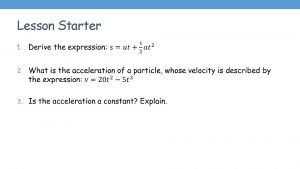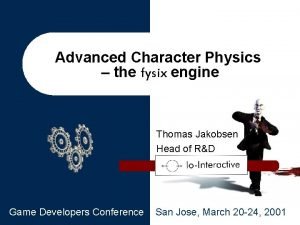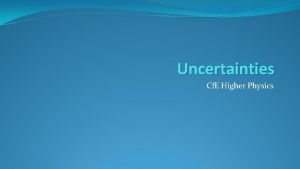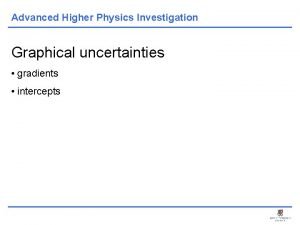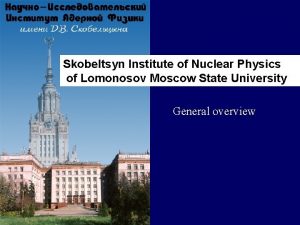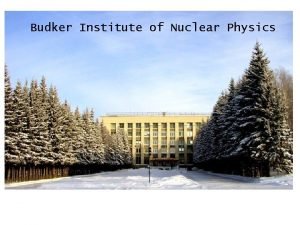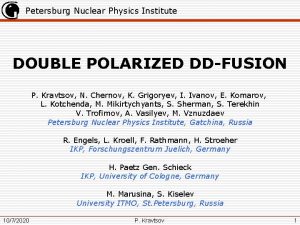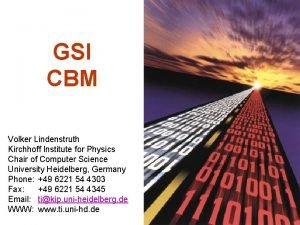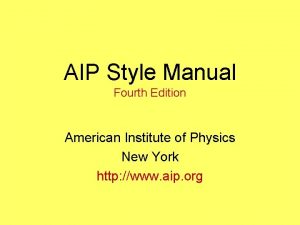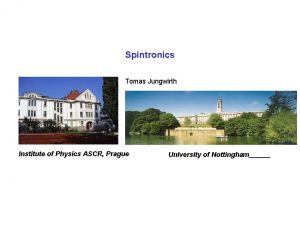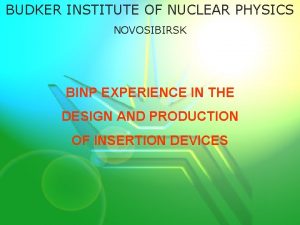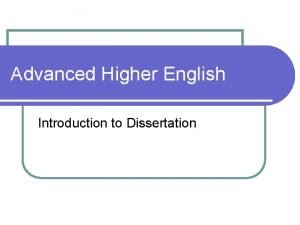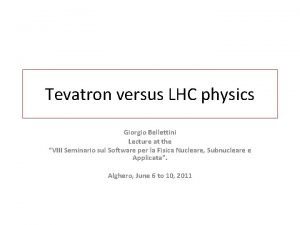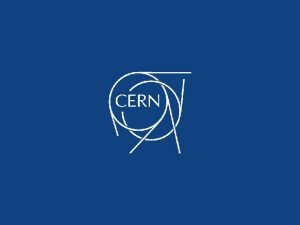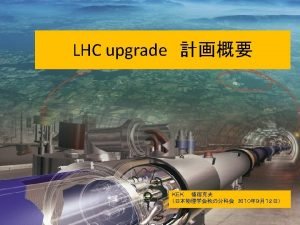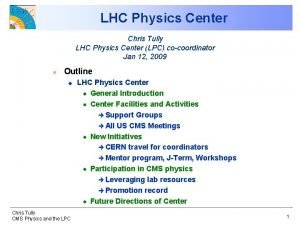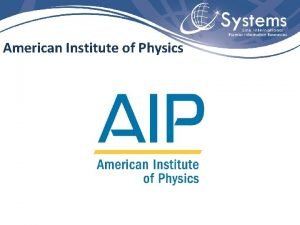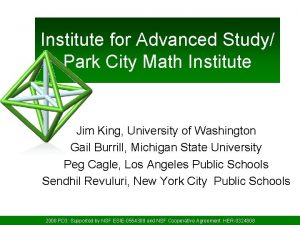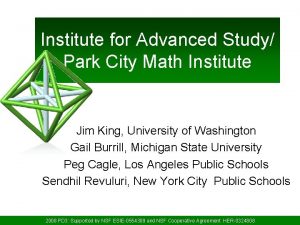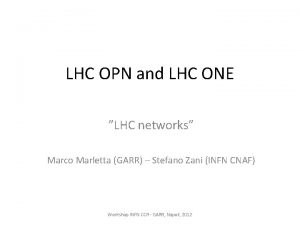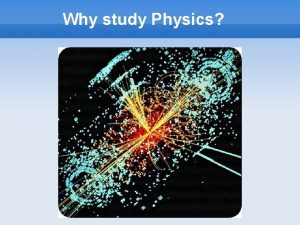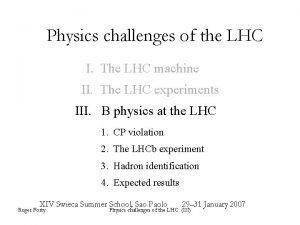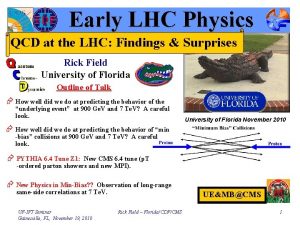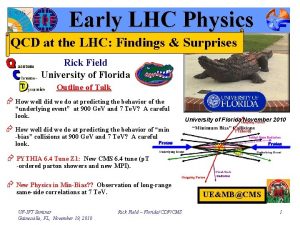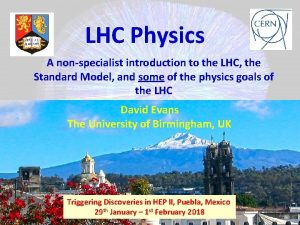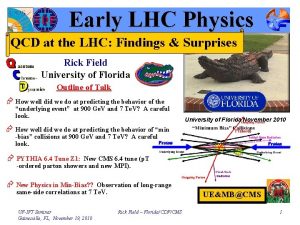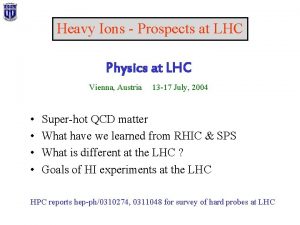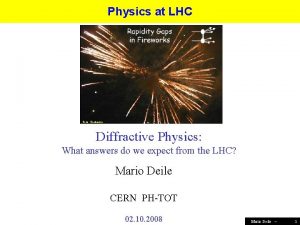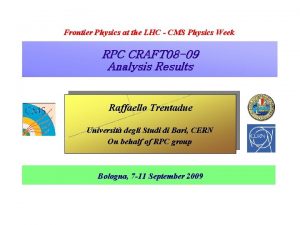Advanced Study Institute Physics at LHC LHC Praha2003













![B 0 K*0 g : Annual yield and CP sensitivity Efficiency, [%] Reconstruction selection B 0 K*0 g : Annual yield and CP sensitivity Efficiency, [%] Reconstruction selection](https://slidetodoc.com/presentation_image_h2/df2dcc9597aef0d53a66c2594d24791b/image-14.jpg)






- Slides: 20

Advanced Study Institute “Physics at LHC”, LHC Praha-2003, B Physics Day, 11/07/2003 Galina Pakhlova, (ITEP, Moscow) for LHCb collaboration Study of exclusive radiative B decays with LHCb Pakhlova Galina , ITEP Moscow

Physics motivation v v v Constraint on CKM matrix elements |Vtd/Vts| from the ratios of decay rates B 0 r (w) g / B 0 K*0 g Bs 0 K*0 g / Bs 0 f g W Search for New Physics b v Direct CP violation ACP < 1% in SM (tiny u quark contribution in loop) t(c, u) up to ~ 10% in SM extensions B 0 K*0 g ; B+ K*+ g ; B K**g ; Bs 0 K*0 g v Mixing-induced CP violation ~0 in SM (different g polarizations in B 0 and B 0 decays ) up to ~ 50% in SM extensions Bs 0 f g ; B 0 K**0 g with K**0 , e. g. K*00 (1430) K 0 s p+p- (Dalitz plot analysis of K 0 s p+p- to extract flavour blind K 0 s r 0 ) v Exotics, super rare decays B 0(s) l+ l- g, B 0(s) g g, etc Test of QCD B K*g , K**g , K np g; Lb L g, etc g s(d) 2

Experimental overview The first exclusive radiative penguin B 0 K*0 g was observed by CLEO in 1993 B 0 K*0 g B+ K*+ g ACP(B K* g) B K* 2 (1430) g (4. 3 ± 0. 4)× 10 -5 (3. 8 ± 0. 5)× 10 -5 PDG 2003 -0. 01 ± 0. 07 PDG 2003 (1. 3 ± 0. 5)× 10 -5 PDG 2003 B+ K+ p- p+ g ; B+ K*0 p+ g ; B K p g ; B K r 0 g Belle B 0 r 0 g ; B+ r+ g ; B 0 w g ; B 0 g g Upper limit BABAR B 0 barion g Upper limit CLEO Statistics at B-factories is still not sufficient for stringent test of SM in CP violation in radiative decays and for observation of b d g 3

B B event at LHCb primary vertex K p B decay vertex Impact Parameter (IP) g B decay distance v Nb hadrons = 10 12 / year v all types of b hadrons v sbb/ sinel ~ 5× 10 -3 v high charged and neutral multiplicity v few primary vertices 4

Challenge v v Electromagnetic penguins are indeed rare B decays v inclusive Br (b s g) = (3. 3 0. 4) × 10 -4 v exclusive Br are ~10 -100 smaller v b d g are further suppressed by |Vtd/Vts|2 v f( b B 0 S) / f( b B 0) ~ 0. 26 Background sources v Huge combinatorial background from generic b b events v Minimum bias events v B X p 0 decays v g / p 0 separation using different shower shape v for X=V polarization can be exploited 5

Search for CP violation v v Direct CP violation v no tag and lifetime analysis are required v Systematic errors are of great importance: fake (non-CP) asymmetries v different B and B production rates in pp interactions v detector asymmetries Hopefully can be calibrated with other final states e. g. B 0 J/y K*0 Mixing-induced CP violation v need to tag B flavour v proper time resolution is critical especially for B 0 S due to fast oscillations (x s >19) to be resolved 6

Can we measure radiative decays at LHCb v v v B 0 K*0 (K+ p-) g Direct CP v Energetic g v huge soft g and p 0 background can be effectively removed dedicated trigger selects high ET photons at Level 0 v two charged tracks v B 0 vertex reconstruction B 0 S f (K+ K-) g Bs decay & mixing-induced CP v small Gf narrow DM(f) cut; small f yield in B decays: v background conditions are more favourable v extremely small opening angle f K+ K- v problem with B 0 S vertex (proper time) resolution B 0 w (p+ p- p 0) g b d g v small Gw narrow DM(w) cut v problem with combinatorial background from p 0 v in progress (not presented here) 7

B 0 K*0 g reconstruction Select K+ p- g combinations Tracks are consistent with K+ & p- hypothesis Reject K+ , p- tracks from all primary vertices (c 2 IP >16) K+ p- produce secondary vertex (c 2 49) | M ( K+ p- ) - M PDG ( K*0 ) | 60 Me. V/c 2 ET (g) > 2. 8 Ge. V (close to L 0 trigger requirement) 2. 2 E*T (g) 2. 7 Ge. V Select primary vertex with minimum IP of B 0 candidate Require B 0 momentum and flight direction to be consistent (q. B 6 mrad) v K*0 helicity angle: in K*0 rest frame |cos (p. B, p. K)|<0. 7 v v v v 8

Background suppression (1) v Require large IP of K+, p- to all reconstructed primary vertex (c 2 IP > 16) v suppress primary tracks v especially effective background suppression in events with multiple interactions N comb No c 2 IP cut optimized c 2 IP > 16 S/ B 9

Background suppression (2) bb inclusive E*T (g) , Ge. V E*T (g), Ge. V B 0 K*0 g ET (g), Ge. V Transverse energy E*T (g) in B 0 rest frame vs ET (g) in the lab frame ET (g) > 2. 8 Ge. V 2. 2 E*T (g) 2. 7 Ge. V powerful against low energy g and p 0 rejects also soft K*0 candidates 10

Background suppression (3) K p reconstructed B 0 momentum q reconstructed primary vertex reconstructed B 0 decay vertex g Angle q between B 0 momentum and B 0 flight direction One of the most powerful cut! esignal ~ 60% ; ebb < 1% v should be 0 for real B 0 candidates (smeared by K p vertex resolution) v randomly distributed for combinatorial background 11

p 0 suppression K*0 helicity: in K*0 rest frame cos (p. B, p. K) Significant suppression of fast p 0 is expected after application of special algorithm for g / p 0 separation based on shower shape (to be implemented soon) Contribution from B 0 K*0 p 0 is small and can be further suppressed exploiting K*0 polarization : K*0 helicity states 0 B 0 K*0 p 0 +1 -1 B 0 K*0 g 12

B 0 K*0 g: signal and background summary ~ 4 min LHCb ~ 54 hours LHCb s = 64 Me. V /c 2 0 events in (4. 5 -6. 0) Ge. V/c 2 mass window after trigger and off-line selection with all available MC statistics ~ 10. 3 M events In blue: contribution from B 0 K*0 p 0 after trigger and off-line cuts 2. 2% of B 0 K*0 g Br (B 0 K*0 p 0) 3. 6× 10 -6 PDG 2003 13
![B 0 K0 g Annual yield and CP sensitivity Efficiency Reconstruction selection B 0 K*0 g : Annual yield and CP sensitivity Efficiency, [%] Reconstruction selection](https://slidetodoc.com/presentation_image_h2/df2dcc9597aef0d53a66c2594d24791b/image-14.jpg)
B 0 K*0 g : Annual yield and CP sensitivity Efficiency, [%] Reconstruction selection trigger & acceptance 4. 5 9. 2 38 total 0. 16 Nyear s (ACP) 35 K < 0. 01 BACKGROUND / SIGNAL < 0. 7 @ 90 % CL Assuming: Br ( B 0 K*0 g ) f ( b B 0 ) = = ( 4. 3 0. 4 ) × 10 -5 0. 39 N ( B 0 K*0 g ) - N ( B 0 K*0 g ) ACP = --------- N ( B 0 K*0 g ) + N ( B 0 K*0 g ) 14

B 0 S f g reconstruction Two different tasks v Branching ratio measurement similar to B 0 K*0 g reconstruction: v v Tracks are consistent with K+ & K- hypothesis v Reject K+ , K- tracks from all primary vertices (c 2 IP > 4) v K+ K- produce secondary Vertex (c 2 49) v | M ( K+ K- ) - M PDG ( f) | 10 Me. V/c 2 v ET (g) > 2. 8 Ge. V (close to L 0 trigger requirements) v 2. 0 E*T (g) 2. 7 Ge. V v Select primary vertex with minimum IP of B 0 S candidate v B 0 S momentum and flight direction to be consistent q. B 12 mrad ( worse B 0 S vertex resolution) v f helicity : in f rest frame |cos(p. B, p. K)| < 0. 7 Search for mixing-induced CP: selection to be re-optimized 15

B 0 s f g : background suppression M ( K+ K- ) After L 0 x. L 1 trigger & off-line cuts bb inclusive: 0 event in mass window (4. 5 - 6. 0) Ge. V/c 2 from ~ 10. 3 M events ( ~ 4 min LHCb) N(B 0 s f p 0 ) / N(B 0 s fg) 4% assuming Br (B 0 K*0 p 0) = Br(B 0 s f p 0 ) 3. 6× 10 -6 Gf GK*0 : narrow DM(f) < 10 Me. V/c 2 Background is mainly due to real f Fortunately small f yield from B decays. 16

B 0 s f g after trigger and off-line cuts ~ 87 hours LHCb Efficiency [%] reconstr. selection trigger & accept. 4. 3 15 34 BACKGROUND / SIGNAL total Nyear 0. 22 9. 4 K < 2. 4 90 % CL limited by MC statistics, expected to be better Assuming: Br (B 0 s f g ) = ( 4. 3 0. 4 ) × 10 -5 f ( b B 0 S) = 0. 10 s = 64 Me. V/c 2 17

Search for mixing induced CP in B 0 S f g Main problem: Proper time resolution is critical: v dominated by poor f K K vertex resolution kaons are almost collinear B 0 S fg proper time resolution simple vertex fit s 1 ~ 160 fs (40%) s 2 ~ 380 fs(60%) v no extra information on B 0 s vertex from g Improvement can be achieved: v Constrain the B 0 s flight direction to B 0 s momentum: (“direction” vertex fit) Improve vertex resolution by factor > 2. 5 “direction” vertex fit s 1~ 62 fs (60%) s 2~ 200 fs (40%) v Select kinematical region with the better vertex (proper time) resolution: (slow f larger K K opening angle) 18

B 0 s f g lifetime resolution cuts re-optimization for CP violation study B 0 S proper time resolution, ps Decay angle q* (between f momentum in rest frame of B 0 s and B 0 s flight direction) is convenient variable to select the kinematical region that provides the better proper time resolution No s ~ 84 fs cos q* 0, (g) > 3. 2 Ge. V, tighter cut E*T (g) Require: ET s ~ 60 fs B 0 S proper time resolution, ps Achieved lifetime resolution is close to those for charged modes. Estimation of CP violation sensitivities is in progress 19

Conclusion B 0 K*0 (K+ p-) g v record statistical sensitivity in direct CP violation s (ACP )< 0. 01 for one year LHCb. Stringent test of SM extensions! v systematic errors to be studied carefully B 0 S f (K+ K-) g v precise measurement of the branching fraction with ~2% accuracy for one year LHCb v For indirect CP violation B 0 S proper time resolution is critical v advanced fit vertex procedure and dedicated cut optimization allow to hope on reasonable sensitivity Others channels of interest v v B 0 w (p+ p- p 0) g |Vtd/Vts| B K** g direct CP violation B 0 K** (1430) ( K 0 s r 0) g mixing-induced CP violation B 0 m+ m- g why not? under study 20
 Lhc tantalizing new physics
Lhc tantalizing new physics Advanced higher physics notes
Advanced higher physics notes Fysix
Fysix Random uncertainty
Random uncertainty Line of best fit in physics
Line of best fit in physics Skobeltsyn institute of nuclear physics
Skobeltsyn institute of nuclear physics Budker institute of nuclear physics
Budker institute of nuclear physics Petersburg nuclear physics institute
Petersburg nuclear physics institute Kirchhoff institute for physics
Kirchhoff institute for physics Aip style manual
Aip style manual Institute of physics ascr
Institute of physics ascr Budker
Budker Understanding standards advanced higher geography
Understanding standards advanced higher geography Higher english techniques
Higher english techniques Advanced higher english dissertation word count
Advanced higher english dissertation word count Why does it happen
Why does it happen University physics with modern physics fifteenth edition
University physics with modern physics fifteenth edition Physics sl ia ideas
Physics sl ia ideas Bellettini
Bellettini Lhc baton rouge
Lhc baton rouge Hl-lhc schedule
Hl-lhc schedule

